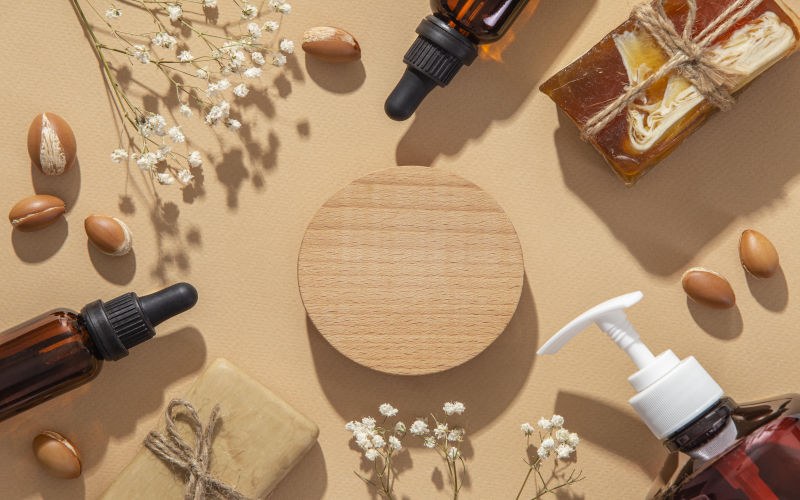How to layer beauty products - and why skincare needs more than 10 minutes

Apply sunscreen generously as the final step in your morning routine and wait at least five minutes before applying makeup.
When it comes to skincare, using the right products is not enough; how you layer them can make or break your results.
That is according to board-certified dermatologist Dr Sam Ellis, who warns that incorrect layering may cause either inactivation of active ingredients or skin irritation, leaving consumers frustrated and confused.
More To Read
- How sunscreen protects your skin and why consistent use is vital
- Why some deodorants cost more - and why cheap isn’t always better
- Scent that stays: Science and secrets behind smelling good all day
- Glow naturally: How to make your own body scrub for radiant, healthy skin
- Kenyan men embrace the glow-up: Grooming gets a masculine makeover
- Flaxseeds for heart, digestion, and beauty—Here’s why you need them
“You could have all the right products, but without proper layering, they may cancel each other out or worse, irritate your skin,” Dr Ellis said in a recent online seminar.
Inactivation or irritation: The two common pitfalls
According to Dr Ellis, inactivation often occurs when powerful actives are layered together without consideration of their chemical interactions.
A common mistake? Combining benzoyl peroxide, often used for acne, with vitamin C.
“Benzoyl peroxide is unstable. When used alongside antioxidants like vitamin C, it can react and destabilise both ingredients, causing your skin to react,” Dr Ellis noted.
Her advice if you want to use it with Vitamin C: “Use benzoyl peroxide in the morning, cleanse thoroughly, allow the skin to dry completely, after 10 minutes, then apply vitamin C, ideally when benzoyl peroxide has been washed off and skin is dry.
Similarly, products with copper peptides and vitamin C should not be layered.
“They interact chemically and reduce each other’s effectiveness; you will be doing skin care but for nothing,” Dr Ellis explained.
Another major warning: Sunscreen
“Don’t apply sunscreen immediately after layering other products or put makeup on top too quickly,” she said.
“Sunscreen needs time to form a stable, even film on the skin. Mixing it with other products or layering makeup right away can destabilise the UV filters and reduce protection.”
She advises allowing 5–10 minutes between layers, especially before and after sunscreen, and not mixing sunscreens.
“Layer them, yes, but mixing different formulations could affect the active ingredients. Because different companies have different ingredients.”
Irritation: When skincare starts to sting
Beyond product inactivation, Dr Ellis emphasised the rising number of users reporting irritation, especially from highly active ingredients like vitamin C, exfoliating acids, and retinoids.
“Vitamin C is formulated at a low pH to be effective, but that also makes it acidic. That acidity can cause stinging, redness, or dryness in individuals with sensitive skin,” she said.
Exfoliating acids - including salicylic acid, glycolic acid, lactic acid, mandelic acid, and azelaic acid - work by accelerating cell turnover, which can compromise the skin barrier if overused.
Retinoids - such as retinol, tretinoin, and adapalene - are another powerful class of actives that cause irritation even when used alone without other products.
“These don’t always play well with other ingredients. You don’t need to stack them. Once you exfoliate, skip retinoids for the night. Alternatively, after skipping a day, use them again after a day off and listen to your skin,” Dr Ellis said.
She recommends limiting exfoliation and retinoid use to 2–3 times a week, never on the same day.
The ideal skincare routine: A step-by-step guide
Dr Ellis recommends following a consistent skincare routine with thoughtful product layering and adequate absorption time between steps.
Step 1: Cleanser
Choose it based on skin type.
For acne-prone skin, double cleansing is recommended (oil cleanser followed by gel-based cleanser).
For dry or sensitive skin: use gentle, non-foaming or hydrating cleansers.
Step 2: Toner
Optional, but effective if you are exfoliating.
Use those with glycolic acid sparingly.
Always allow 10 minutes before moving to the next step.
Step 3: Essence or serum
Tailor to your concern:
Vitamin C (used for brightening)
Niacinamide (for pore control and oil control)
Hyaluronic acid (for hydration)
Step 4: Eye cream
Dr Ellis said you should dab the eye cream gently, no rubbing, because the skin around the eyes is 50% thinner and more delicate.
“Look for ingredients like caffeine, vitamin C, and retinol (low concentration),” she said.
Step 5: Moisturiser
Choose the texture based on weather: Have two.
Gel-based for hot or humid days
Cream-based for cold or dry environments
Step 6: Sunscreen
Apply generously as the final step in your morning routine and wait at least 5 minutes before applying makeup.
If your makeup contains SPF, that is a bonus, but never skip dedicated sunscreen.
Skin Types and Layering Recommendations
Oily/acne-prone skin:
Use lightweight products like gel moisturisers and water-based serums. Avoid over-layering or using multiple oils.
Dry/sensitive skin:
Focus on hydration and barrier repair with ceramides and fatty acids. Limit active use to prevent flaking and burning.
Combination skin:
Target treatment zones. For example, apply salicylic acid to oily areas and hydrating serums to dry patches.
“Skincare is personal. Your skin is a living organ, just like your liver or stomach; it speaks to you. If a product tingles, burns, or peels, stop immediately. Take a break, and remember less is more, consistency is all that matters,” Dr Ellis advised.
As trends push consumers toward elaborate routines, Ellis advocates for smart simplicity: use fewer products, give them space to work, and always prioritise skin health over hype.
Top Stories Today
Reader Comments
Trending













































